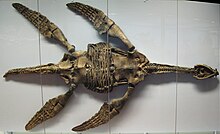Plesiosaur size

Plesiosaurs are extinct marine reptiles.
Record sizes

In general, plesiosaurians varied in adult length from between 1.5 metres (5 ft) to about 15 metres (49 ft). The group thus contained some of the largest marine apex predators in the fossil record, roughly equalling the longest ichthyosaurs, mosasaurids, sharks and toothed whales in size. Some plesiosaurian remains, such as a 2.9 metres (10 ft) long set of highly reconstructed and fragmentary lower jaws preserved in the Oxford University Museum and referable to Pliosaurus rossicus (previously referred to Stretosaurus[1] and Liopleurodon), indicated a length of 13 metres (43 ft)[2]. However, it was recently argued that its size cannot be currently determined due to their being poorly reconstructed. MCZ 1285, a specimen currently referable to Kronosaurus queenslandicus, from the Early Cretaceous of Australia, was estimated to have a skull length of 2.85 m (9 ft).[3]
Plesiosaurs
The longest known plesiosauroid was Elasmosaurus at 14 metres (46 feet) long.
Longest plesiosaurs
- Elasmosaurus platyurus: 14 m (46 ft)[4]
- Hydrotherosaurus alexandrae: 13 m (43 ft)[5]
Heaviest plesiosaurs
- Elasmosaurus platyurus: 2 t (2.0 long tons; 2.2 short tons)[4]
Pliosaurs
Longest pliosaurs
- The NHM symphysis: 9.1–15.1 m (30–50 ft)[6] (hypothetical)
- The Peterborough Vertebra: 11.6–14.2 m (38–47 ft)[6](hypothetical)
- Pliosaurus rossicus/Pliosaurus macromerus: 11.4–12.7 m (37–42 ft)[6]
- Monster of Aramberri: 11.7–12.4 m (38–41 ft)[6][7]
- Pliosaurus funkei: 10–13 m (33–43 ft)[8]
References
- ^ Tarlo, L.B.H., 1959, "Stretosaurus gen nov., a giant pliosaur from the Kimmeridge Clay", Palaeontology 2(2): 39-55
- ^ McHenry, C.R., 2009, Devourer of Gods: the palaeoecology of the Cretaceous pliosaur Kronosaurus queenslandicus
- ^ Benson, R. B. J.; Evans, M.; Smith, A. S.; Sassoon, J.; Moore-Faye, S.; Ketchum, H. F.; Forrest, R. (2013). Butler, Richard J (ed.). "A Giant Pliosaurid Skull from the Late Jurassic of England". PLoS ONE. 8 (5): e65989. doi:10.1371/journal.pone.0065989.
{{cite journal}}: CS1 maint: unflagged free DOI (link) - ^ a b "Elasmosaurus - paleofilescom".
- ^ Welles, S.P. (1943). Elasmosaurid plesiosaurs with a description of the new material from California and Colorado. University of California Memoirs 13. pp. 125–254
- ^ a b c d McHenry, Colin Richard (2009). "Devourer of Gods: the palaeoecology of the Cretaceous pliosaur Kronosaurus queenslandicus" (PDF): 1–460.
{{cite journal}}: Cite journal requires|journal=(help) - ^ Buchy, M.C., 2007, Mesozoic marine reptiles from north-east Mexico: description, systematics, assemblages and palaeobiogeography
- ^ "A new species of Pliosaurus (Sauropterygia: Plesiosauria) from the Middle Volgian of central Spitsbergen, Norway". Norwegian Journal of Geology. 92 (2–3): 235–258. 2012. ISSN 0029-196X.
{{cite journal}}: Unknown parameter|authors=ignored (help) Low resolution pdf High resolution pdf
